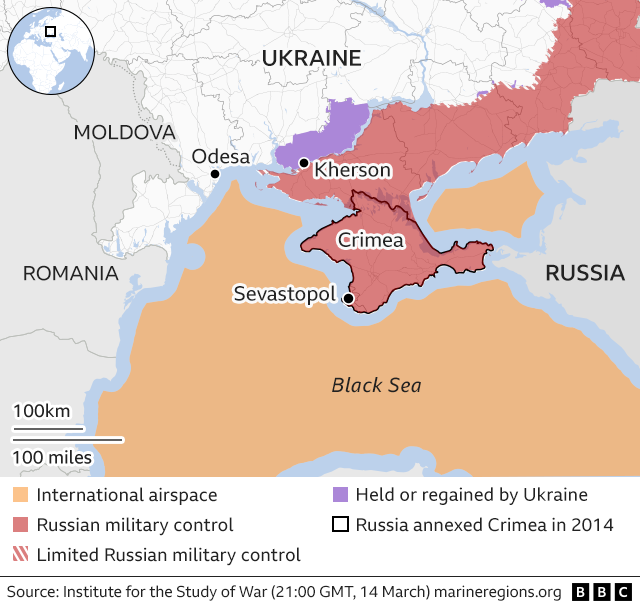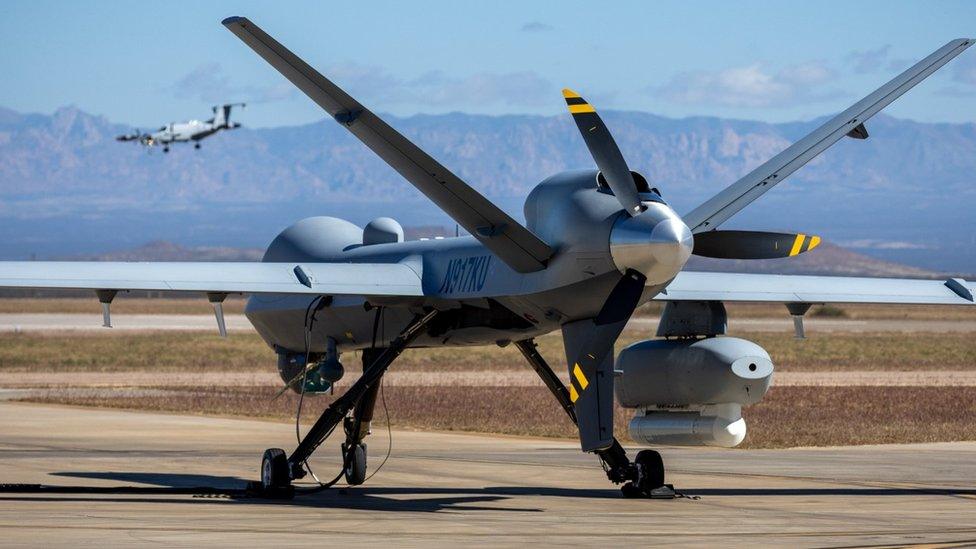Everything we know about the US drone that crashed in the Black Sea
- Published
Watch: US releases footage from its drone of the encounter with a Russian jet
A US drone that crashed into the Black Sea is at the heart of a new row between Washington and Moscow. Does newly released footage of the incident bring us any closer to knowing what happened?
The US has said it brought down the drone after a Russian fighter jet clipped it.
But Moscow has denied this, saying the drone caused its own failure.
On Thursday morning, the Pentagon released a video of the incident.
This is what we know so far.
Video shows broken propeller
The declassified video, which is 42 seconds long, shows a feed from a camera fitted under the fuselage of the surveillance drone.
A Russian SU-27 is seen making two extremely close passes while releasing what appears to be fuel as it approaches.
The first pass goes overhead but the second one is even closer - disrupting the video feed from the remotely piloted aircraft.
When the picture returns, a blade of the drone's propeller at the back of the aircraft can be seen bent out of shape.
Russia has claimed the drone was approaching its territory, but all we can see from the video is sea, sky and cloud.
The US has said the confrontation lasted 30-40 minutes so there is no sense from this video what happened before or after what is shown.
It remains unclear where the incident took place and the video does not help locate it.
US and Russia can't agree on what happened
The US said its unmanned MQ-9 Reaper drone suffered propeller damage on 14 March after two Russian Su-27 jet fighters intercepted it over the Black Sea.
One jet struck the drone, forcing US forces to bring it down in international waters, an official said, squarely blaming the near-miss on the actions of the Russian pilot.
Russia denies this version of events and blames the crash on a "sharp manoeuvre" performed by the drone. Moscow also denies that any of its jets were damaged.
Russian officials said the drone was flying with its communication transponders turned off, and that it had violated restricted airspace.
After being summoned to speak to officials in Washington, Russian ambassador to the US, Anatoly Antonov, said Moscow saw the drone incident as "a provocation".

A race to find the debris
Russia has confirmed that it is attempting to recover wreckage of the drone, which may have sunk to depths of up to 5,000 feet (1,500m) below the surface.
"I don't know whether we'll be able to retrieve it or not but it has to be done," Russian security council secretary Nikolai Patrushev said on state TV.
At least two Russian ships have been seen at the location where the drone crashed.
But General Mark Milley, America's top military general, said they had taken steps to prevent any sensitive data from falling into Russia's hands.
The US does not have any ships in the Black Sea, he said, complicating search and recovery efforts, but it does "have a lot of allies and friends in the area".
A key question - was collision deliberate?
State Department spokesman Ned Price told reporters that "the best assessment right now is that it probably was unintentional".
"It probably was the result of profound incompetence on the part of one of these Russian pilots."
Prof Michael Clarke, visiting professor in war studies at King's College, told the BBC the collision was "almost certainly an accident".
The ex-director general of the defence and security think tank Royal United Services Institute said: "I don't believe any pilot could deliberately do that without seriously endangering their aircraft and their own life."
Regardless of intent, these incidents are very dangerous due to escalation, says US General David Berger, commandant of the US Marine Corps.
His biggest fear, he said, is a collision that is intentional or unintentional but creates an international crisis.

The incident happened as tensions over the Black Sea have been running high ever since Russia's widely-condemned annexation of Crimea in 2014.
And since Russia's full-scale invasion of Ukraine in 2022, the US and the UK have stepped up surveillance flights in international airspace.
US drone crash inevitable, Ukraine minister tells BBC
Related topics
- Published14 March 2023

- Published15 March 2023

- Published15 March 2023
